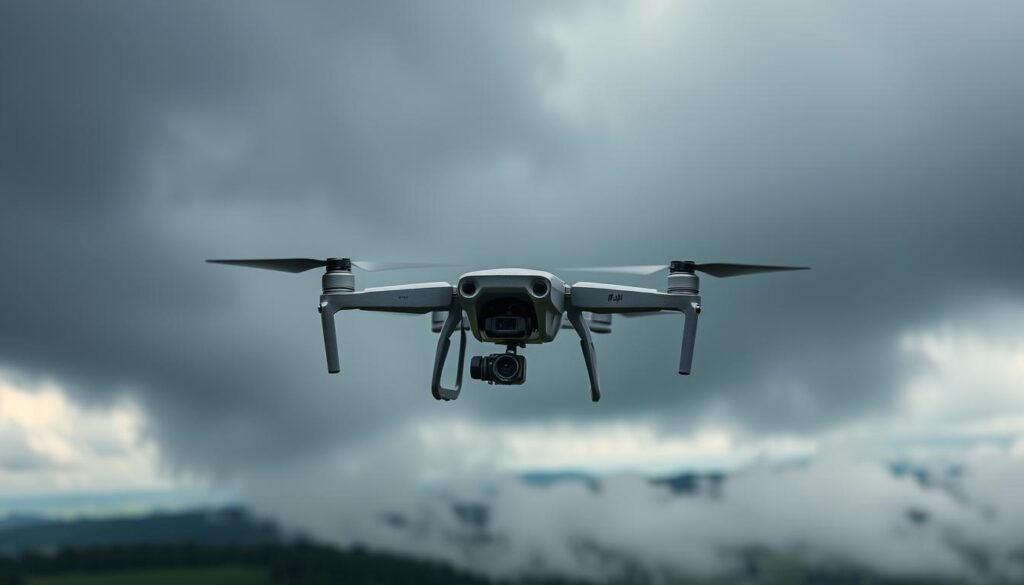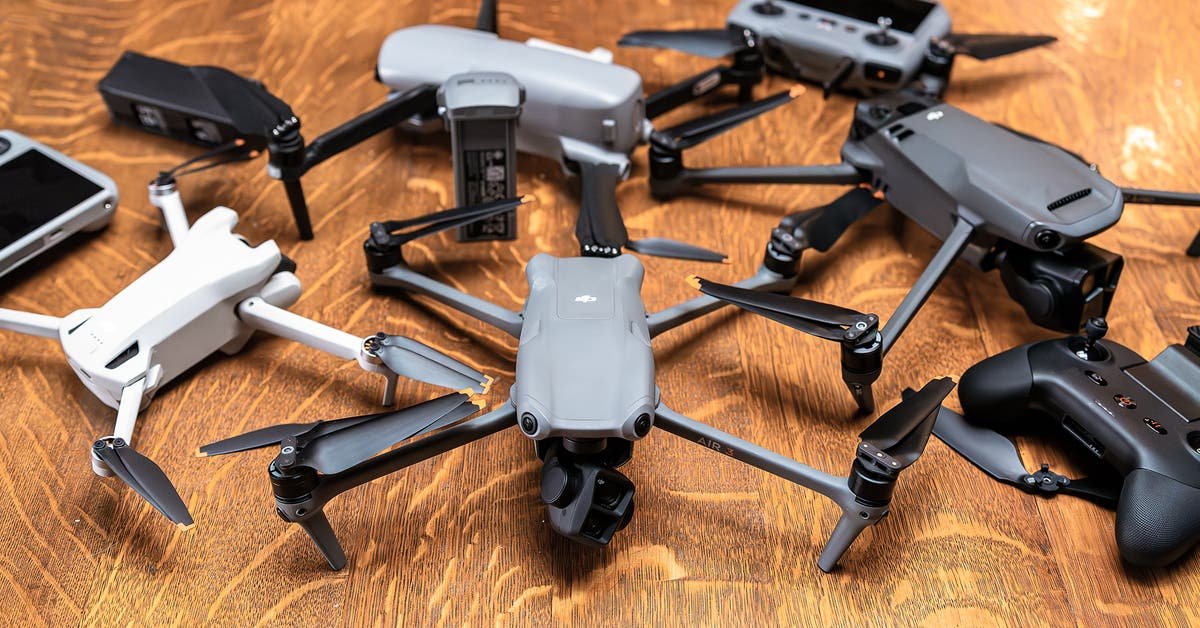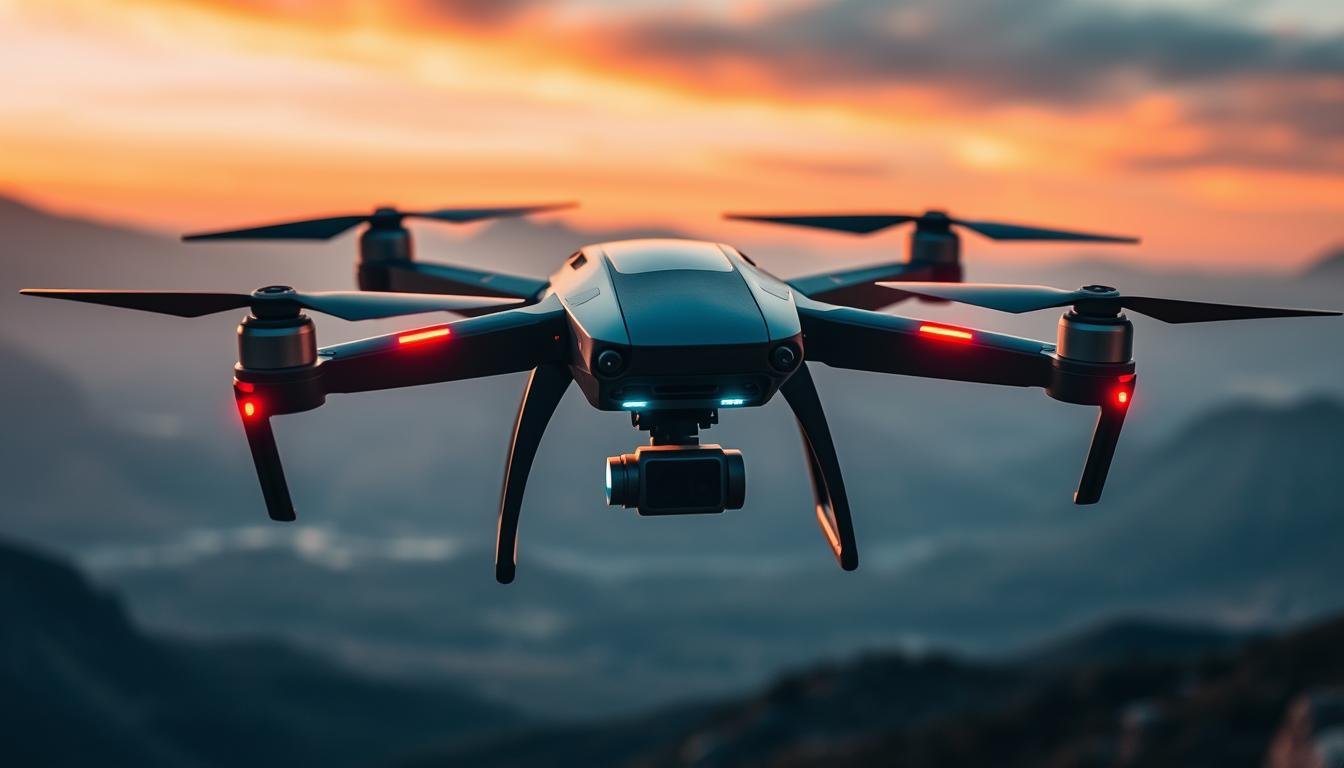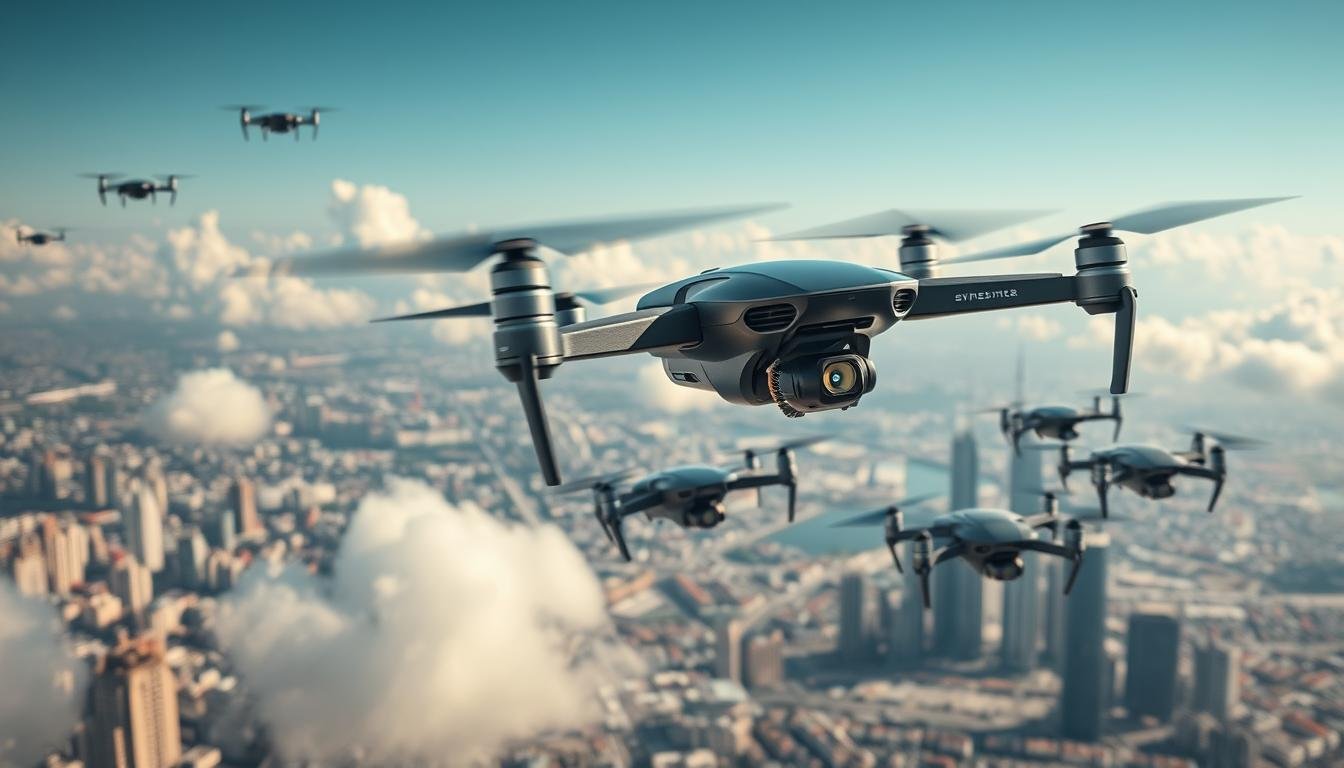I love taking amazing aerial photos, even when it’s raining. But flying a DJI Mini in the rain makes me think about safety and how well it works. Many ask, “Can you fly a DJI Mini in the rain?” and if it’s worth the risks.
Things like water damage and how well drones fly in the rain are big concerns. In this article, I’ll talk about the dangers, share what other users have said, and explain the DJI Mini’s features. This way, you’ll know what to expect before flying in bad weather.
Key Takeaways
- Flying a DJI Mini in rain can lead to potential moisture damage.
- Most consumer drones, including the DJI Mini, are not water-resistant.
- Drone performance can be severely impacted in rainy conditions.
- User experiences vary significantly between light and heavy rain flights.
- Understanding the specifications of your drone can help assess its flight capabilities in adverse weather.
- Following safety guidelines is essential for responsible drone operation in any weather.
The Risks of Flying a DJI Mini in Rainy Conditions
I often think about the risks of flying DJI Mini in rain. Water and electronics don’t mix well. This is a big worry. Flying in rain can damage the drone because of moisture.
Moisture can cause corrosion and short circuits. Many users say even light rain can harm the drone. It can damage the motor windings and other parts over time.
Experts say not to fly in rain. Moisture damage might not show right away. But it can cause problems later, like poor performance or not working at all.
Users have shared stories of drying their drones after misty flights. This shows how vulnerable drones are to moisture.
Rain is a big risk for the DJI Mini’s life and work. Only some drones, like the DJI M200 series, can handle rain. For aerial photography, flying in rain is very risky.
It’s important to be careful and know our drone’s limits. This can help avoid moisture damage to drones.
Understanding Drone Water Resistance
It’s key to know the difference between waterproof and water-resistant for drone fans. This helps me decide when to fly my DJI Mini in different weather. Waterproof means you can fully submerge it without damage. Water-resistant means it can handle some moisture but not too much.
The DJI Mini is water-resistant, so I must be careful in wet weather.
Waterproof vs Water-Resistant: Key Differences
When looking at drone specs, it’s important to understand these terms:
- Waterproof: Can be fully submerged for a long time without damage.
- Water-Resistant: Can handle some moisture, but avoid it for a long time.
The market has many options, but not all are the same. Knowing this helps me make better choices when flying in the rain.
DJI Mini Specifications for Weather Exposure
The DJI Mini’s specs show how it handles weather. Flying in light rain might seem okay, but it’s risky. A study found that a Mini 3 Pro failed in just three seconds in moist conditions.
On the other hand, the FIMI X8 Pro has an IP43 rating. This means it’s protected against dust and water, making it better for wet places. Also, the Phantom Rain Wet Suit can seal the drone, improving its water resistance.
Can You Fly a DJI Mini in the Rain?
Many people wonder, can you fly a DJI Mini in the rain? Some have tried flying in light rain, but most say to be careful. They’ve seen flight distances vary a lot, from 318 feet to 6,980,351 feet. This shows how unpredictable flying in the rain can be.
People say the DJI Mini isn’t made to handle water like the DJI M200 series. They worry about the motor windings getting wet. One person even used a blow dryer to dry the motors after a rainy flight.
Experts say it’s key to keep water out when flying in the rain. They warn against using motor caps because they can block cooling. Official advice is to not fly in rain, fog, or snow. Without protection, like the Wet Suit for the DJI Mini 3, sensors can fail fast.
In short, while some might try flying in light rain, it’s risky. The best advice is to stay on the ground when it’s wet outside.
Real User Experiences with DJI Mini in Rain
Many drone pilots share their stories about flying the DJI Mini in the rain. They say flying in light rain can work out, but you must be careful and quick to return. But, flying in heavy rain is a different story. It can make the drone unstable and cut its battery life short.
Flight in Light Rain vs Heavy Rain
Reports on flying in light rain show the DJI Mini does well. Here are some key points:
- Some pilots flew up to 15,283 feet, showing the drone’s flexibility.
- Drone models like the Mavic 2 and Phantom series used rain wet suits. But, there were doubts about their use in heavy rain.
- Using a waterproof drone, like the Splash drone, was seen as better than the DJI Mini in wet conditions.
But, flying in heavy rain is a different story. Users shared:
- There’s a higher risk of water damage to motors, which can fail if exposed too long.
- Wet suits might make the drone less stable in flight.
- Experts advise against flying in very heavy rain to avoid performance issues and damage.
Long-term Effects of Moisture on Drones
Moisture can harm drones over time, a big worry for many. Some pilots flew in light rain without problems. But, the long-term risks of moisture became clear:
- Light moisture can slowly damage drone parts, like motors and electronics.
- Water can get into the drone and cause problems weeks or months later.
- There are protective solutions, like the Phantom “wetsuit,” but they’re not perfect.
Experts suggest using protective coatings and making sure drones are well-ventilated. They warn that even with protective products, caution is key. This is especially true for high-risk uses, like by the military or first responders.
| Experience Type | Conditions | Reported Issues | Flight Distance |
|---|---|---|---|
| Light Rain | Drizzle | Minor video obstruction | Up to 15,283 ft |
| Heavy Rain | Driving Rain | Reduced stability, motor concerns | Varied, often less than light rain |
These shared experiences show that flying the DJI Mini in rain is possible. But, it’s important to understand the risks and how they can affect the drone over time. Knowing the details can help keep drones safe and working well.
Recommendations for Safe Drone Operation in Rainy Weather
To fly drones safely in the rain, be proactive. Don’t take off when it’s bad outside. Always check the weather forecast first.
Be careful of sudden weather changes while flying. If it starts raining, land your drone fast.
Protective accessories can help. But, don’t count on them too much. The DJI Mavic 3 series isn’t fully waterproof.
Every drone has its limits. Talk to other users to learn more. This way, you’ll know what to expect.
Keep your drone and accessories dry when flying in the rain. After flying in wet weather, follow these steps:
- Remove the battery
- Dry the drone well
- Put moisture-absorbent bags in the storage area
- Let everything air out
These steps help your equipment last longer.
While it’s tempting to fly in the rain, most people don’t. Water on camera lenses can ruin your video. Knowing your drone’s weak spots helps you make safer choices.
| Drones | Water-Resistant Rating | Recommended Actions in Rain |
|---|---|---|
| DJI Mavic 3 | Not Waterproof | Avoid flying, rinse after exposure |
| DJI Mini 2 | Light Rain Resistance | Short flights, use covers |
| DJI Inspire 1 | Not Designed for Rain | Avoid wet conditions |
In short, know your drone’s strengths and weaknesses. Follow these tips for a safer flying experience in the rain.
Understanding DJI Mini 2 Specifications
The DJI Mini 2 has exciting features compared to the original Mini. It has better video quality and longer battery life. Both drones can get damaged by moisture, but knowing this helps me fly safely.
Comparing Models: DJI Mini vs Mini 2
Looking at the DJI Mini and Mini 2, we see big differences:
Micro-SD SupportUp to 128GBUp to 256GB
| Feature | DJI Mini | DJI Mini 2 |
|---|---|---|
| Video Resolution | 2.7K | 4K |
| Battery Life | 30 minutes | 31 minutes |
| Weight | Approximately 249g | 237-242g |
| Transmission System | Standard | OcuSync |
| Price | $399 | $449 |
The DJI Mini 2 has better specs, but both drones are sensitive to moisture. It’s important to take care of them to avoid damage.
Moisture Damage Considerations for Different Models
Both drones can get damaged by moisture. Users share stories of drones getting wet and the damage it causes. They say water can change the color of parts inside.
After getting wet, it’s key to dry the drone out. People use desiccants and air to dry it. They also warn about being careful with batteries after they get wet. It’s important to keep both drones dry to avoid damage.
How to Protect Your Drone from Moisture Damage
Keeping your DJI Mini safe from moisture damage is key. I’ve learned that using certain strategies can really help. It’s all about taking extra steps and doing maintenance after flying to keep your drone working well, even in wet conditions.
Using Accessories for Enhanced Protection
Getting good accessories for DJI Mini is a smart start. Here are some great choices:
- Rain Covers: These offer a protective layer to keep water out during sudden rain.
- Desiccants: Putting desiccants in your case helps control humidity by absorbing it.
- Silicone Covers: A silicone cover can protect your drone from a little moisture.
- Wetsuits: There are special wetsuits for drones that offer better moisture protection.
Recommended Maintenance After a Rainy Flight
After flying in the rain, taking care of your drone is very important. Here’s what I do:
- Remove the battery right away to stop water from getting to the electrical parts.
- Use a fan to dry out the inside, making sure air moves through all parts.
- Wipe the outside with a microfiber cloth to get rid of extra moisture.
- Look for any signs of corrosion or damage to parts.
By following these steps, I keep my drone safe from moisture damage. The right gear and regular maintenance after flying make sure my DJI Mini is always ready for the next adventure.
| Maintenance Action | Description | Purpose |
|---|---|---|
| Battery Removal | Take out the battery to prevent electrical damage. | Protects electronics from short circuits. |
| Air Drying | Utilize a fan to circulate air through the drone. | Aids in evaporating hidden moisture. |
| Surface Wipe | Clean the exterior with a microfiber cloth. | Removes surface moisture and contaminants. |
| Component Inspection | Check for corrosion or damage post-flight. | Identifies potential issues early. |
Official Guidelines from DJI User Manual
The DJI user manual guidelines are key for safe flying with DJI drones, like the Mini series. DJI warns against flying in rain or snow. This advice is also common in the drone world, showing the need to keep your drone dry.
Knowing your drone’s features is important for safe flying. For example, the DJI Mini 3 Pro works best between -10°C to 40°C (14°F to 104°F). Always check your phone and controller connection before flying. DJI suggests setting the “Remote Controller Signal Lost” feature to “Return to Home” (RTH) mode. This ensures your drone goes back home if it loses signal.
| Feature | Details |
|---|---|
| Max Flight Time | 34 minutes with Intelligent Flight Battery; 47 minutes with Intelligent Flight Battery Plus |
| Max Flight Distance | 18 km with Intelligent Flight Battery; 25 km with Intelligent Flight Battery Plus |
| Max Wind Speed Resistance | 10.7 m/s (Level 5) |
| Max Ascent Speed | 5 m/s in S Mode |
| Max Descent Speed | 5 m/s |
Following the DJI user manual guidelines and DJI’s official advice helps keep my drone safe and working well. Before each flight, I review these guidelines. This makes flying more fun and safe.
Weather Conditions Ideal for Drone Flights
The weather is key for safe drone flying. I look for clear skies, little wind, and no rain. These help my drone fly well and take great photos.
Good weather cuts down on flying risks. Fog can make it hard to see and navigate. So, I always check the weather forecast before flying.
Sunny days are best for drone flying. The drone works better and is more reliable. It’s important to fly in safe weather to avoid damage or losing the drone.
- Clear skies are best for seeing well.
- Little wind helps avoid shaking.
- Stay away from fog, rain, and storms.
- Think about how temperature affects batteries.
Getting ready to fly in the right weather keeps me safe and my drone in good shape. This makes flying more fun and gets better results.
Best Practices for Responsible Drone Piloting
Responsible drone flying means following rules and knowing drone flight best practices. In the U.S., drones between 0.55 and 55 pounds need FAA registration. Always fly below 400 feet and stay at least five miles from airports without permission.
Keeping your drone in sight is key. It lets you quickly handle any dangers.
My seven years of flying drones show the importance of planning. Make sure your drone has enough battery for safe landings. Aim for at least 15% battery left. Flying low on battery can cause crashes or loss of control.
Knowing responsible drone piloting means more than just flying. It’s also about being aware of your surroundings. Respect privacy and avoid flying over people and buildings.
Regular checks and getting ready before flying are also important. Calibrate your drone’s IMU, compass, and gimbal for the best performance. Also, avoid flying in bad weather or strong winds, especially with smaller drones.
Conclusion
Flying DJI Mini in rain is not always safe. These drones can handle a little moisture but too much can harm them. People have had different experiences with rain, from good flights to serious damage.
It’s important to know how to take care of your drone. Using special sprays can protect it from light rain. This shows how key it is to be ready for any weather.
The safest thing to do is not fly in bad weather. Knowing your drone’s limits and the best weather for flying is key. Following these tips can make flying safer and more fun.













